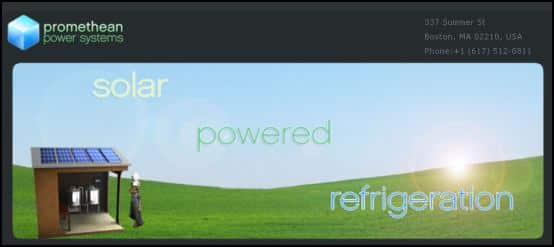SOLAR HYBRID MILK CHILLER
Solar Hybrid Milk Chiller runs partly on solar energy and partly on electricity. In April 2010, Sorin Grama and Sam White, the two founders of PPS set up their milk chiller as a pilot project in Savoi Verem in Goa. In just one month the system proved its worth by making it possible to chill milk instantly at the collection centre itself, thereby curtailing the bacterial growth and increasing the quality of milk. This complete, rural refrigeration system is designed for mission-critical refrigeration applications that must operate 24 hours a day, 365 days a year. The combination of solar and grid power provides a necessary backup mechanism and eliminates the need for a dedicated diesel generator. When compared with conventional Bulk Milk Coolers (BMCs), PPS milk chiller provides significant advantages. The milk chiller has a cooling capacity of 250 litres per day and storage capacity of 500 litres. A large storage capacity enables the collection centres to despatch milk every alternate day thereby reducing the transportation cost in half. Since the chiller uses solar energy for part of its energy input, the operating cost is 50% lower than the operating cost of an equivalent grid-powered unit and nearly 80% lower than that of a diesel-powered unit. The system contains a rapid chiller which cools raw milk immediately from ambient to 10oC. This results in a much lower bacterial count in milk which enables dairies to reach the export market, implement organic milk farming, or create value-added products like high-quality cheese.
SOLAR POWERED – COLD STORAGE
Milk cooling requires a lot of power at a very specific time—morning and evening collection periods—when neither solar power nor grid power may be available. PPS refrigeration system uses a thermal battery system to store cold energy during daytime using solar power and nighttime using grid power. Majority of rural areas in India do have grid power, but the power is unreliable. Power outages occur daily due to load shedding restrictions or inadequate supply for the growing demand. Supplementing the solar power with any available AC power results in a system that is more economical and provides critical backup for mission-critical applications such as milk cooling. A “black-box” electronic control unit runs the entire system, minimizing energy consumption and optimizing the use of available solar and grid power. The hybrid-power optimizer uses proprietary algorithms to efficiently transfer solar and grid power to the thermal battery and electrical loads. To reach the cost and power consumption goals, for milk cooling, the heat exchanger cools milk immediately to arrest bacteria growth and maintain milk quality according to international standards.
